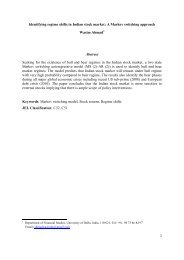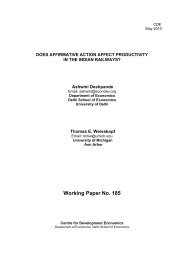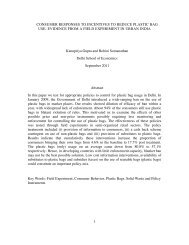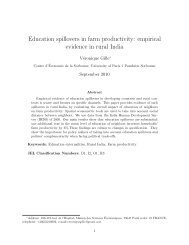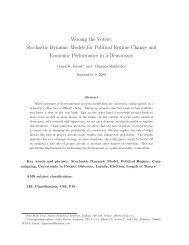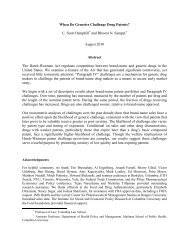Dismantling the Legacy of Caste - Centre For Development Economics
Dismantling the Legacy of Caste - Centre For Development Economics
Dismantling the Legacy of Caste - Centre For Development Economics
You also want an ePaper? Increase the reach of your titles
YUMPU automatically turns print PDFs into web optimized ePapers that Google loves.
Caucutt, E. (2002), ―Educational Policy When There Are Peer Group Effects: Size Matters,‖<br />
International Economic Review, 43, 195–222.<br />
Chambers, David L., Timothy T. Clydesdale, William C. Kidder, and Richard O. Lempert (2005), ―The<br />
Real Impact <strong>of</strong> Eliminating Affirmative Action in American Law Schools: An Empirical Critique <strong>of</strong><br />
Richard Sanders’ Study,‖ Stanford Law Review, 57(6), 1855-1898.<br />
Chalam, K. (2007), ―<strong>Caste</strong>-Based Reservations and Human <strong>Development</strong> in India,‖ Sage Publications,<br />
New Delhi, India.<br />
Chan, J. and Eyster, E. (2003), ―Does Banning Affirmative Action Harm College Quality?‖ American<br />
Economic Review, 93(3), 858–873.<br />
Chung, K. (2000), ―Role Models and Arguments for Affirmative Action,‖ American Economic Review,<br />
90, 640–648.<br />
Coate, S. and Loury, G. (1993), ―Will Affirmative Action Policies Eliminate Negative Stereotypes?‖<br />
American Economic Review, 83, 1220–1240.<br />
Dale, S., and A. Krueger (2002), ―Estimating <strong>the</strong> Pay<strong>of</strong>f to Attending a More Selective College: an<br />
Application <strong>of</strong> Selection on Observables and Unobservables,‖ Quarterly Journal <strong>of</strong> <strong>Economics</strong>, 1491-<br />
1527.<br />
Darity, William, Ashwini Deshpande, and thomas Weisskopf (2011), ―Who Is Eligible? Should<br />
Affirmative Action be Group- or Class-Based?‖ American Journal <strong>of</strong> <strong>Economics</strong> and Sociology, 70(1),<br />
238-268.<br />
Deshpande, Ashwini (2001), ―<strong>Caste</strong> at Birth? Redefining disparity in India,‖ Review <strong>of</strong> <strong>Development</strong><br />
<strong>Economics</strong>, 5(1), 130-144.<br />
Deshpande, A. (2005), ―Affirmative action in India and <strong>the</strong> United States,‖ Background Paper, World<br />
<strong>Development</strong> Report.<br />
Duflo, Es<strong>the</strong>r, Pascaline Dupas, and Michael Kremer (2010), ―Peer Effects, Teacher Incentives, and <strong>the</strong><br />
Impact <strong>of</strong> Tracking: Evidence from a Randomized Evaluation in Kenya,‖ working paper, MIT.<br />
Epple, D., Romano, R., and Sieg, H. (2002), ―On <strong>the</strong> Demographic Composition <strong>of</strong> Colleges and<br />
Universities in Market Equilibrium,‖ American Economic Review: Papers and Proceedings, 92 (2),<br />
310–314.<br />
_________ (2006), ―Admission, Tuition, and Financial Aid Policies in <strong>the</strong> Market for Higher Education,‖<br />
Econometrica, 74(4), 885-928.<br />
_________ (2008), ―Diversity and Affirmative Action in Higher Education,‖ Journal <strong>of</strong> Public Economic<br />
Theory, 10(4), 475-501.<br />
33



